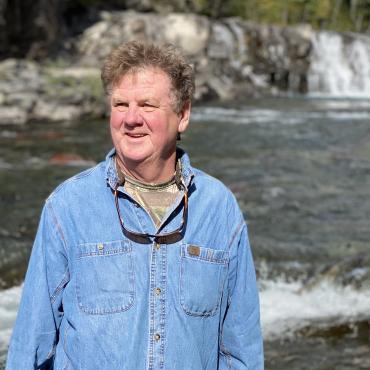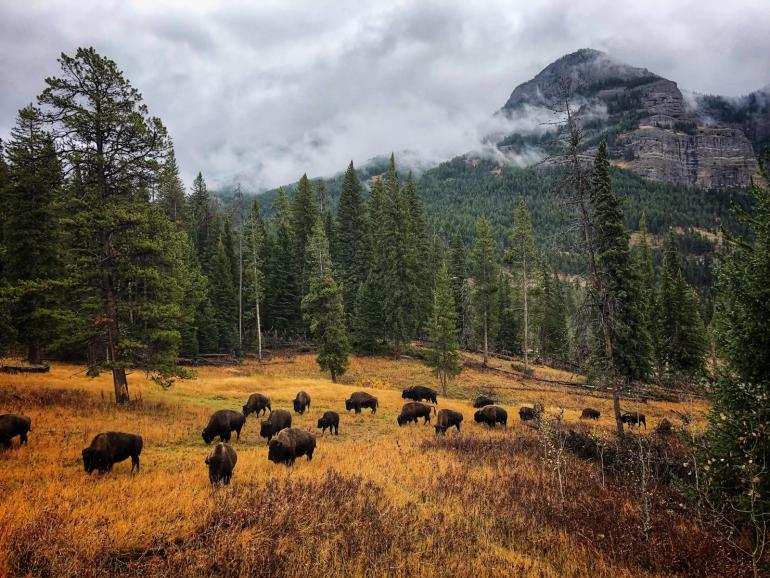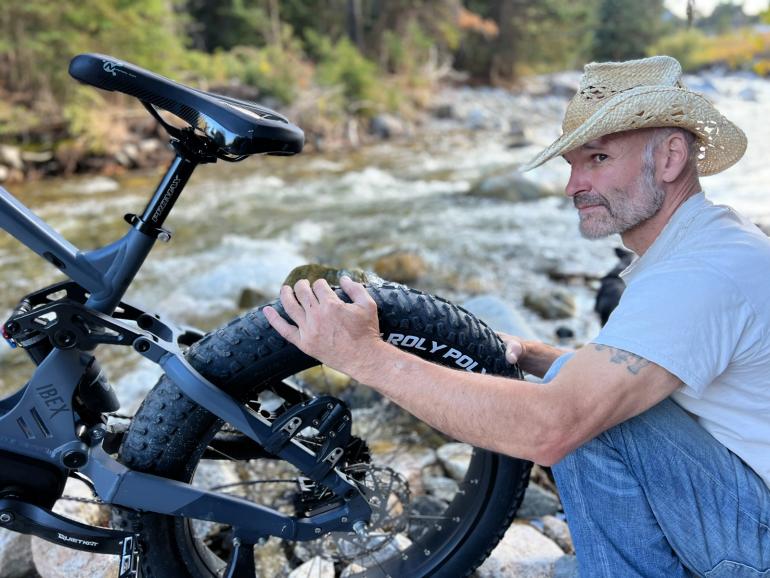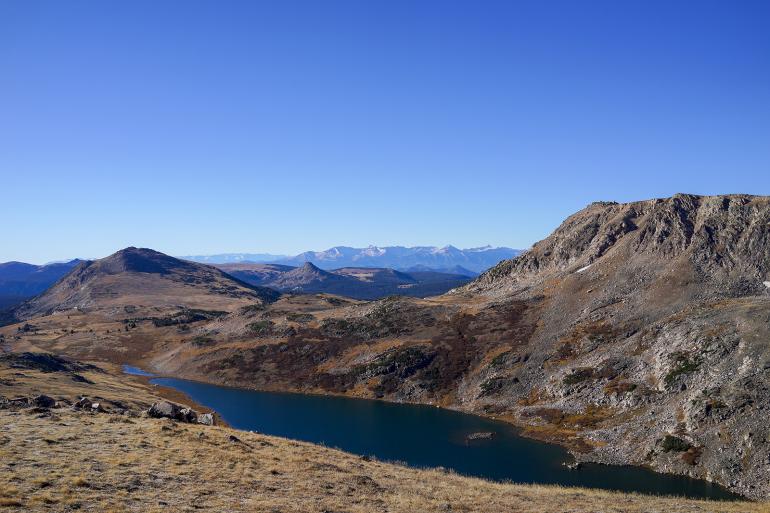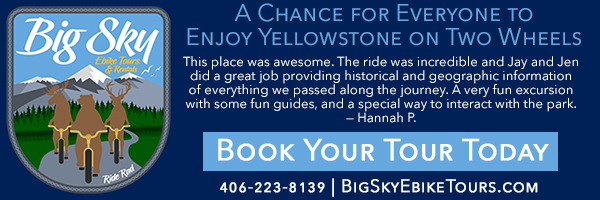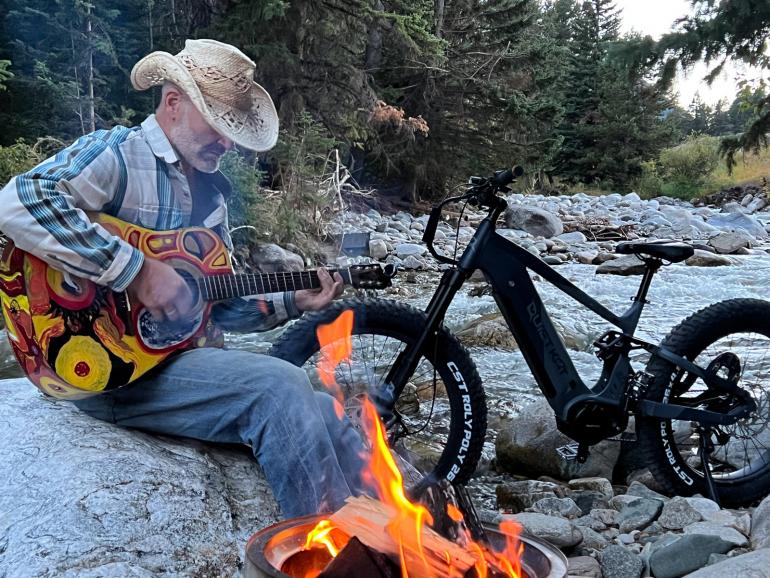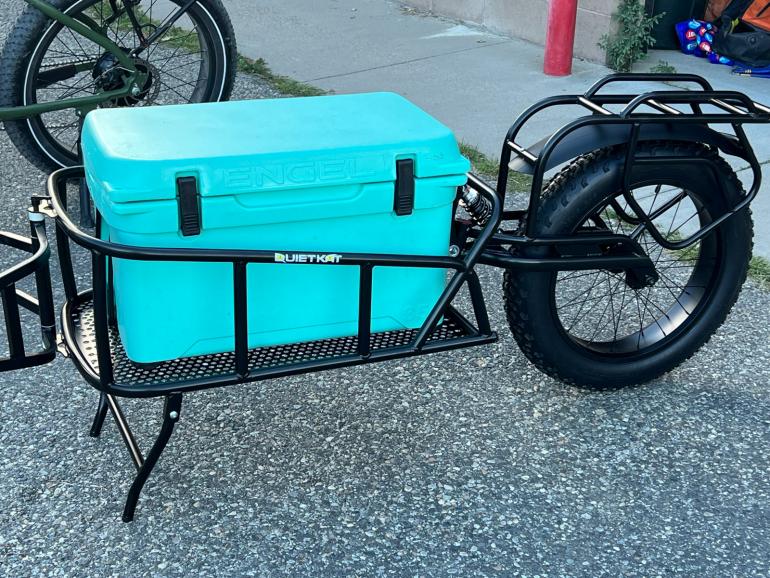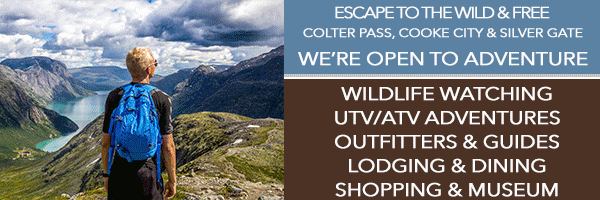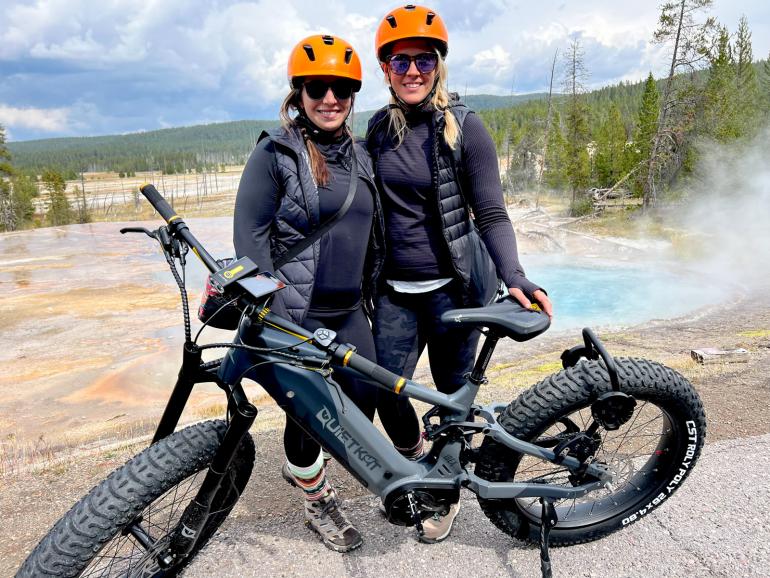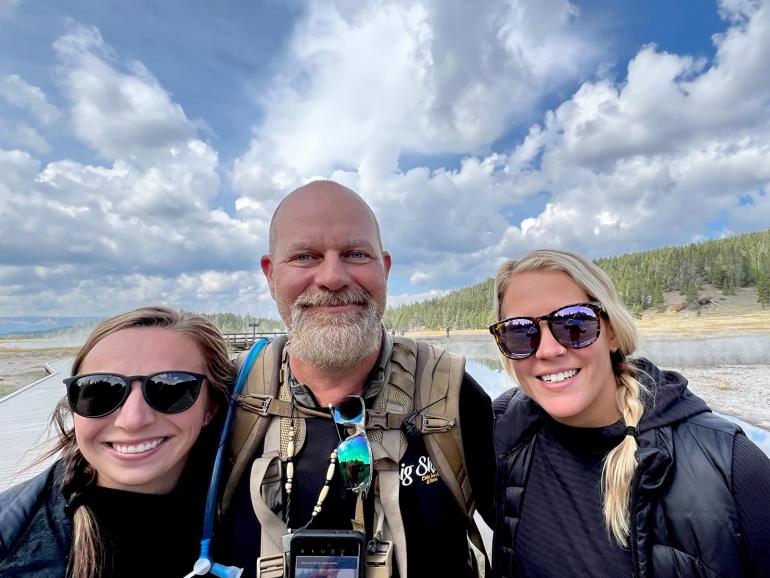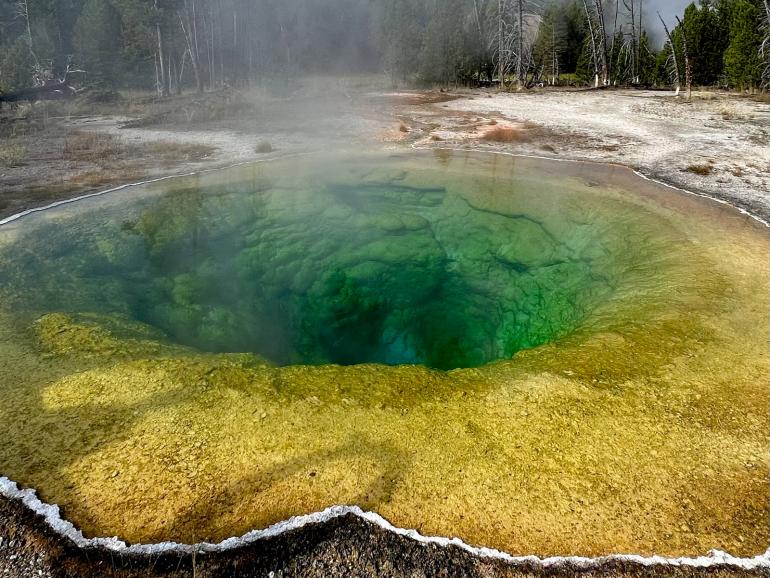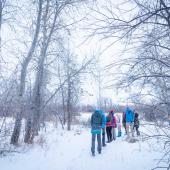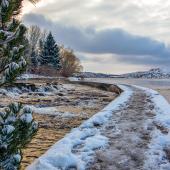Quiet Time
Exploring the Greater Yellowstone Ecosystem by electric bike.
For the past several weeks, I’ve been touring Yellowstone National Park and nearby national forests on an electric mountain bike. The e-bike combines all of the elements necessary for my cycling outings: I can carry enough camping gear for an extended trip, while still getting plenty of aerobic exercise.
Electric bikes, with capable, low-impact, off-road tires, are enjoying a surge in popularity. Critics may sneer that they are “cheater bikes,” but because one can ride an e-bike longer and farther, the calories burned often equal out. As more people start using them, the Forest Service is reevaluating its trail-management policies, with plans to open more trails to electric bikes in the future.
Getting with the Times
My friend Hunter White, a 55-year-old Red Lodge metal artist and accomplished outdoor athlete, recently joined me for a ride on Beartooth Pass. We rode the QuietKat Ibex, a rugged bike built for overland riding, fishing, and hunting. “This bike gives you a sense of freedom," Hunter told me. "It takes you to places you never thought you could go before, because you didn’t have the power to do so. It's so much fun!” He was right: the five-range power settings and multiple gears provided plenty of strength to ascend steep inclines toward our nearly 11,000-foot high-point, while four-piston hydraulic brakes offered unparalleled stopping power for the downhill ride. The 21-amp-hour battery with eco, sport, throttle, and walk modes gave us around 60 miles of range. “An e-bike makes those hard rides worth doing again," Hunter said afterward, with a big grin. "Especially if you’re my age. We rode some pretty fun stuff today."
My bike was set up by local QuietKat dealer Gary Fields at Diesel Pros in Belgrade. Fields has extensive experience hunting deer, elk, and birds on his e-bike. “These bikes are about quietly accessing where you hunt. The e-bike allows you to reach and scout your hunting spot without the noise and intrusion of an ATV or 4-wheel drive truck,” said Fields. “This bike has revolutionized how I hunt.” And with its payload of 300 pounds, carrying a big buck off the mountain is a lot easier on the body.
Sounds of Yellowstone
Earlier this summer, severe flooding closed access to many parts of the Park. Additionally, increased fuel and travel costs have lowered visitor numbers. But diligent explorers have been rewarded with the experience of a lifetime: stunning herds of bison and elk, endless scenic vistas, and a rare, mostly pristine soundscape. Soon, access will be open from both the north entrance in Gardiner and the northeast entrance near Cooke City. Both towns serve as great base camps, and they would really appreciate your business after many months with few visitors.
One of the highlights of quietly traveling the less-crowded Greater Yellowstone Ecosystem is the opportunity to truly hear many of our western birds. The Merlin Bird ID app makes learning about birds easy. When riding, just listen for birds, point your phone at the sound, and tap “Sound ID.” Within a few seconds, the app identifies the bird and provides a photo, a full description, and the species’ repertoire of calls. Another great resource is Listening to a Continent Sing (Princeton University Press, $22) by Donald Kroodsma. The ornithologist rode his bicycle across the United States for over five months and recorded thousands of bird sounds.
Within a minute or two, I realized something was very different: it’s perfectly quiet.
There are several great rides in the Park to check out this fall. I recently enjoyed a tour from Dunraven Pass downhill to the Tower-Roosevelt Junction: a breathtaking, steep, and winding route, filled with the fragrant scent of whitebark pine. Long, beaming sun-rays peeked past the Absarokas to the northeast, illuminating the vast grasslands where wolves teach their hungry pups the last hunting lessons before a cold, rapidly-approaching winter.
The steep, winding descent down the Grand Canyon of the Yellowstone was lined by deep shadows hiding precipitous rhyolite cliffs. The low humming of the electric bike and whirring fat tires were accompanied only by a shrieking cacophony of white-throated swifts nesting in the crevices.
Around the next bend, a tiny black-bear cub bounded across the road. Braking, I looked left as the mama bear slapped at her twin cub, scurrying him uphill. Easing off the right shoulder, I rolled to a safe distance and stopped. Within a minute or two, I realized something was very different: it’s perfectly quiet. In many years of exploring Yellowstone, it’s been very difficult—if not impossible—to find true quietude anywhere near the roads filled with delighted, noisy tourists.
From the canopy of the hillside pines, the fussy, rattling song of a male western tanager echoed through the trees. As the cubs wrestled close by, the hungry mama bear clawed at a downed pine log. Strips of bark flew in the bright sunlight, revealing tasty larvae full of calories. The cubs, too busy sparring, missed the morsels of protein. All was silent but the sound of her claws ripping at the bark and her huffs and grunts as she tried to roll the log.
Nearing Tower Junction, I was greeted by a squawking common raven, perhaps wondering why the normally food-rich dumpsters were empty. The road northwest into the Lamar Valley, perhaps the most iconic wildlife-viewing opportunity in North America, has been closed for several months. Only NPS personnel, a few eco-tour guides, and road-repair trucks have pierced the peace. The abundant wildlife (with the possible exception of the dumpster-diving ravens) have seemingly enjoyed the tranquility.
A herd of grazing bison appeared next. With no manmade sounds, I experienced only the intimate sounds of the herd. A big bull grunted and snorted as he lumbered along with the rest of the herd. For an in-depth look at the cultural significance of bison in the American West, pick up a copy of Bison: Portrait of an Icon (Gibbs Smith, $50). The Crow Spirit voice said, Bisha kun dauk kook (“The buffalo are returning.”). Crow tribal elder Henry Real Bird remarks, “Our hearts beat as one with the buffalo and Mother Earth.”
More Two-Wheeled Touring
Jay O’Connor, a perpetually enthusiastic e-bike tour guide, owns Big Sky E-Bike Tours in Gardiner. He started offering tours in 2019. Needless to say, 2022 has been a challenging year, but O’Connor has made the most of it and created new tours as guided access to the Park has slowly opened. One of his favorites is the “Bike & Soak” tour utilizing the Old Yellowstone Trail, biking beneath Devil’s Slide where riders can see pronghorn, elk, deer, and bison. The six-hour tour stops for a picnic lunch overlooking the Yellowstone River and ends with a relaxing soak at Yellowstone Hot Springs.
Although the Park’s north and northeast entrances are projected to open by November 1, most of the other Park roads will close to automobile traffic on November 1. As usual, bikers are allowed unique access through November 15. "This window affords bicyclists an opportunity to ride 54 miles from Gardiner to West Yellowstone," explains O’Connor. "With no automobiles to worry about, you get the feeling the Park is all yours. The only traffic jams you'll have are bison and bear jams. Keep a safe distance and have your bear spray easily accessible.”
This ride is a true adventure. Be prepared for changing weather conditions. Warm layers, waterproof gloves, and rain gear are imperative. Make sure to pack your bike tools and spares, and know how to repair your bike. With limited cell service and all facilities closed, you’re on your own. "The silence gets deep into your soul!” O’Connor proclaims.
The six-hour tour stops for a picnic lunch overlooking the Yellowstone River and ends with a relaxing soak at Yellowstone Hot Springs.
O’Connor has also developed a guided day-long tour highlighting the Park’s thermal and geyser features. Departing Gardiner at 7 am, guests are shuttled by car to Old Faithful to watch the iconic geyser erupt and visit the stunning Old Faithful Inn. A paved trail starts from the old General Store parking lot. From there, it’s a short ride to Morning Glory Pool. Following the edge of the Upper Geyser Basin, the trail provides stunning stops at the Daisy and Grotto geysers. Following along a narrow, densely-forested trail to Biscuit Basin, you’ll discover a boardwalk leading to a unique set of hot springs, geysers, and steam vents.
After exploring the area around Old Faithful, the tour transfers to Firehole Lake Drive. This road gained notoriety in 2014 when it began to melt, with rumors postulating that the Yellowstone Caldera was about to erupt. Well, no eruption yet, but you can still see the rippled puddles of asphalt where the hotspots were. Eight years later, the road is still closed to vehicles, but it’s now a fun bike ride with lots of close access to geysers and hot pools. One of the first features encountered is the Firehole Spring. Then it’s on to the White Dome geyser, which erupts about every 30 minutes. Expect good wildlife viewing, but be alert for bison. You might spot a coyote quietly hunting for mice.
This Yellowstone e-bike cruise ends with what some consider the most iconic view in Yellowstone: Grand Prismatic. The tour avoids the crush of traffic by parking at the Fountain Freight Road trailhead. The eight-mile round-trip road is closed to automobiles and is an easy ride. Black and grizzly bears forage in the surrounding forest, so carry your bear spray and be aware of your surroundings.
For more information on riding electric bikes in and around Yellowstone Park, visit bigskyebiketours.com.

